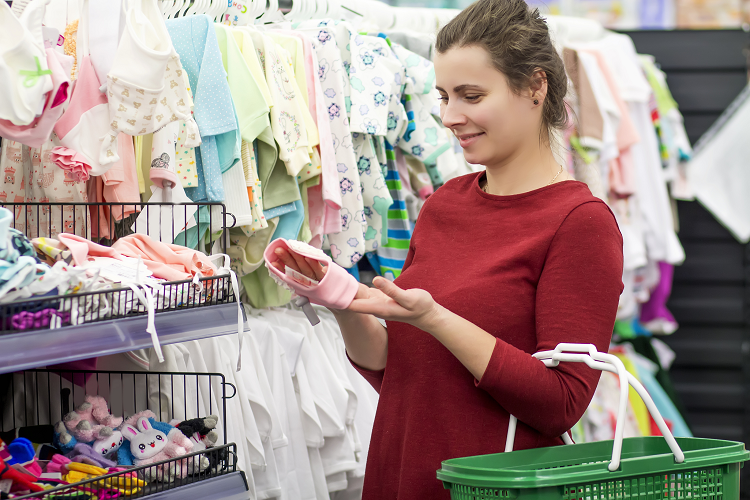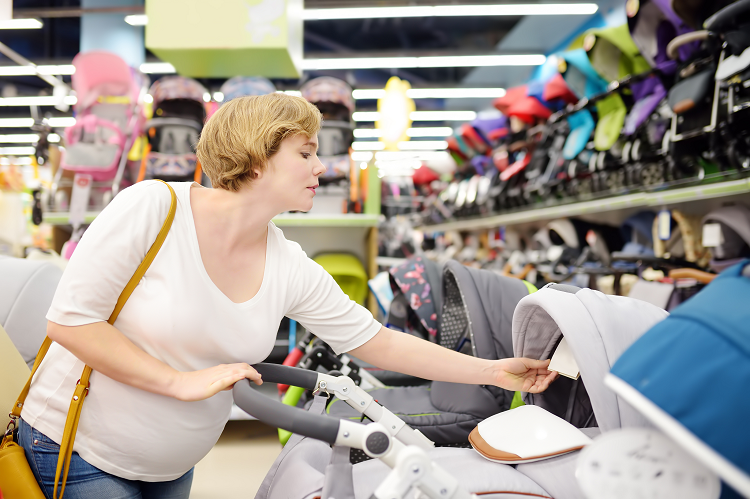
Resale Shopping for Baby
Interested in resale shopping for your baby or child? I began resale shopping about the same time I began buying my own clothes. And when my children came along, the whole family became consumers of resale. There are so many reasons to consider resale shopping for baby and for you entire family!
Less environmental impact.
Every garment purchased second-hand means one less new one produced, which is important because regardless of material, the production of clothing is costly to the environment. Transportation-related pollution also decreases when clothing is re-used, as new clothes are much more likely to travel long distances before being sold than are their second-hand counterparts.
Resale shopping saves money.
One of my all-time favorite sweaters that I wore for years cost less than $3. We probably don’t need to explain why saving money is a good thing! The desire to pay less, search for a fair price, hunt for bargains, and the gratification in having paid a bargain price are key motivational factors for resale shoppers. These savings can be passed down to help with quality of life purchases, college/retirement savings, and other family needs, regardless of your economic background.
Secondhand clothing is often higher quality than comparatively-priced clothing.
For it to be sold resale, it has had to stand some wear and still be durable and salable. This means you’re contributing less to landfills—but it also means less frustration over incidents like when your toddler spills grape juice down the front of their white Tommy Hilfiger t-shirt (that you bought resale!). Mass market or luxury, if people can find a high-quality product for much less, they’ll choose used. Research shows that 64% of women over age 18 bought second-hand products in 2019 versus 45% in 2016.*
Buying local helps the local community.
All of us want to help our communities by buying locally. Resale businesses with a storefront buy almost 100% of their inventory locally and hire locally, which means anything you are selling or buying is recycled back into the local economy.
Resale Shopping Options Abound.
What comes to mind when you think of buying or selling second-hand clothing and products? Thrift stores like Goodwill? Clean, bright stores that sell high end, gently used goods like Once Upon a Child? Online resale like eBay and others? Consignment stores in your neighborhood or children’s clothing resale fairs, swaps, and sales that occur seasonally and throughout the year? Consider the following definitions as well as the pros/cons for each before you decide! There are so many options out there – pick the ones best for you and your family:
Resale Stores with a Storefront:
A “resale shop” is the phrase most used for stores that buy their merchandise outright from individuals based on their projections and knowledge of what sells and for how much, and then they resell the items. They display items attractively, advertise for customers and handle the entire sale process. Rather than wait for your items to sell as you might with a consignment store or website, a resale store will give you cash or store credit for the items you want to sell on the spot (buy more clothes and items for baby…or take your spouse out on a date, for example!).
Because they give cash or credit up front, resale retailers are fully vested in marketing and supporting the goods and validating their cleanliness, safety and quality. Most have strict guidelines as to what they buy from individuals to ensure their customers get the best product available – clean, meeting all safety standards, looking as new as possible, and working as expected. The product at these types of stores tends to be higher quality with better brand names. In addition, most resale stores of this type train their staff to perform safety checks to ensure products are meeting compliance standards and to ensure there haven’t been recalls on items so new parents can feel secure buying and selling. Why pay retail when you can purchase high-end, brand-name resale that looks brand new or very gently used for half the price or less?
They take all the risk and do most all the work so they may pay you a smaller percentage on some items of what they will sell it for. Nevertheless, you are guaranteed money or credit on the spot versus waiting for months for cash or credit you can use now!

Consignment Shops with a Storefront:
Consignment stores accept merchandise on a consignment basis, paying the owners of the merchandise a percentage when and if the items are sold. The majority of such shops pay the owners from 40 to 50% of the selling price and have a policy of displaying goods anywhere from 30 to 90 days, although there are a wide range of policies and percentages depending on the store you choose.
Consignment standards can be different than resale standards as they don’t have money invested in the product since they must wait to sell it before being paid; therefore, they may not worry as much about the quality or safety standards of the items. Be careful to ensure items don’t have rips, fadedness, or features that aren’t working quite right. In most cases, you will find some great bargains and have fun searching among it all if you have plenty of time. For sellers, you may not mind waiting to be paid right away or want to make a slightly bigger profit over the longer term.
Thrift Stores:
A thrift store, such as Goodwill or Salvation Army, is a store run by an IRS designated 501(c)3 organization (non-profit). Buying items at thrift store helps support a cause and eliminates the work of having to prepare and sell items yourself. In addition, you can obtain a tax receipt to write-off donated items, although this is much harder to do under current tax law. Be sure to take pictures of the items donated for your tax files.
Thrift stores don’t have any investment in the product, so quality standards and brands may not be as high as you might find elsewhere. Inspect items carefully and do your research before purchasing baby items and clothing. Note: Although they are non-profit, some thrift stores allocate a good deal of profits to salaries and administrative costs of their organization. Review the ratings on charity websites like CharityNavigator.org or CharityWatch.org to learn about how money generated from donated goods is used and to find charities your family supports.
Online Resale:
Entrepreneurs often buy used items for resale or personal use on internet sites such as eBay, ThredUP, Poshmark and similar sites. They all have their own rules and contracts. The upside of selling on auction sites like eBay is that you can really start the bidding wars. On the other hand, if you’re trying to buy, there’s usually no shortage of selection, but trying to find what you need amongst thousands of categories and products can be frustrating, not to mention the stress one can feel watching the bid prices shoot up every other second on coveted items.
The convenience some websites provide means that sellers take a noticeably lower cut, but the no-fuss process makes it super easy for busy moms. Research all rules. Buying and selling items online is a great option; however, remember you can’t touch and feel the products there, and returns can be quite a hassle. In addition, there’s a good deal of work involved for some sites, like taking and posting photos of the item, researching prices per item, corresponding with interested parties, shipping out the item when it sells, and dealing with unhappy buyers. Do your homework with each site and pick the one that works best with the time you have available.
Selling to Friends/Garage Sales/Pop-Up Sales:
We’ve all been there. Bags upon bags of children’s clothing, old Christmas decorations, and odds and ends sit in our closets or attics and then one fine sunny day we say, “Let’s have a garage sale!”. These are fun events for the family to organize around and can be profitable and community-building, especially if you are having a neighborhood sale where you draw in more crowds.
The downside? Prices may be low, but watch out for quality and safety of products. For sellers, the hours you may have to invest in tagging and sorting items, determining prices, and organizing others to help may or may not be worth it. In addition, garage sales or clothes swaps can be a gamble to due weather and the unknown (e.g. will your sale draw enough people looking for your child’s sizes and products)? Another idea is to sell to friends, but if you are like me, you may feel guilty about asking for the price you want or requesting money at all. Nevertheless, having the social interaction these events provide with your community, friends and family is the real focus, and if a bargain is struck or found, that is the bonus!
How to Find Your Kind of Store:
Keep in mind that online reviews can be negative sometimes, despite all the good ones. Be skeptical and experience the stores/websites yourself. In the case of resale, you might have customers who may be unhappy when items are rejected for sale or if they don’t get the money that they thought the items were worth. With online or brick and mortar consignment, perhaps their items don’t sell and they blame the store. For thrift, items bought may not have be the quality expected. You get the picture.
Explore the store or website beforehand. Do they sell the type of merchandise you want to bring in or purchase? Look for quality of materials when buying and know the retail prices of items you are shopping for to appreciate how much money you can save shopping resale. Talk with the staff about their procedures; they should provide a handout or direct you to online instructions. Make sure to fully understand the shop’s terms before you consign or sell and their return policies before purchasing. Be sure the entity you buy from has invested in training to ensure the safety of the products sold. Finally, sign up for your favorite stores’ mailing list for special offers, sales and other valuable information!
Save Money, Make Money, & Buy Locally!
- Statistic from ThredUp’s 2019 Resale Report, https://www.thredup.com/resale
Written by Jenn Rogers, JR Media.
The opinions expressed in this piece are of the author. Every effort has been made to provide correct information. Read more articles about pregnancy and parenting here!

Leave your comment